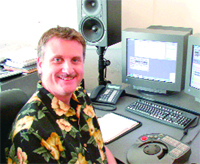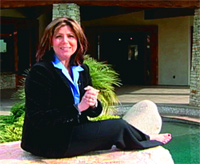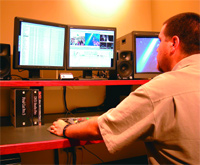FilmCore (www.filmcore.com) in Santa Monica has been using a network since 1998 - early for a creative editing company. Technical director Richard Breniser came to the company from Encore Video, where he had been supporting networked post production systems for feature films. "Some commercial editing houses tried using SANs [Storage Area Networks] for centralized media storage," he recalls. "An early version was based on the SCSI system used on features, but those systems had limited expandability. You couldn't continue to grow."
Then came Fibre Channel-based SANs, "the technology that most post companies use now," Breniser says. FilmCore had been using a Fibre Channel-based form of Avid MediaShare for about a year when Avid approached with an early version of its Unity MediaNetwork solution. FilmCore was impressed with Unity's expandability and potential for future growth.

Scott Hill (right), who edited Win a Date With Tad Hamilton! on a Lightworks Touch, used IBM's Tivoli SANergy Software, which enabled a Rorke SAN.
|
"Unity has been very good to us," reports Breniser. "It's totally expandable and flexible. We have a couple of terabytes of storage now and are planning to add more to accommodate our increasing need for space." FilmCore is also using MediaManager, Avid's file management system with a browser-based user interface.
It's essential that FilmCore's editors and assistants have simultaneous access to media assets. "With Unity, assistants work at the same time on the same material - even the same cut - as the editors, pulling and cutting sound effects, doing compositing or visual effects," Breniser notes. "They can send their version to drop into the sequence with no copying, no moving material." A big MSN campaign, out of McCann-Erickson/SF, required five editors to pull from the same source material at the same time, he adds. It consisted of four :30s and five :60s, each of which had 24 versions tailored for different markets.
FilmCore installed Avid's LANShare EX in its San Francisco office. The cost-effective system accommodates up to six Fibre Channel-based workstations (the office currently has five Avid Meridien Media Composers attached via Fibre) but "works and feels like the Unity we have in Santa Monica" where there are nine Meridien Media Composers.

FilmCore's Rick Breniser and editor Doug Walker (L-R) use Avid's LANShare EX to work between their LA and San Francisco studios. The system was used on this recent MSN campaign.
|
"Tony Cox, my counterpart in San Francisco, and I try to make the two offices appear as one," notes Breniser. "When Doug Walker, who's based in San Francisco, works down here, he logs in as if he were in his home office. Everything he's used to having there, he has here and vice versa."
FilmCore complements its MediaNetwork with a parallel Ethernet infrastructure to maximize workflow. The Ethernet ties in an Apple Xserve rack-optimized server and Xserve RAID data storage, enabling FilmCore editors in Santa Monica or San Francisco to easily mirror and sync up material. "It's a very robust, high-end networking infrastructure that provides support, reliability, ease of configuration and remote access," Breniser says.
Today FilmCore can digitize dailies on the network and copy the media to FireWire so editors can plug into Avid Xpress Pro systems for on-location cutting. Finished sequences can be sent back to the office for further finessing. "Doug Walker took Xpress on a laptop home for the holidays to prep a job for January," he notes.

Shadow and Lights
|
Editors like Walker can also log on remotely to FilmCore's Intranet to access the sound effects library, graphics, titles, and cuts and dailies bins that are stored on the Ethernet. They can also send EDLs and OMF files back to the office. "We're trying to create a facility without walls," says Breniser. "Before, editors were always tied to a building. But we don't want to confine them. We want them to have the same functionality they have here anywhere they go."
Breniser, too, can take advantage of networking. He can remain at home with his newborn while remotely logging and fixing FilmCore systems. Using a DSL connection, he accesses a Virtual Private Network (VPN) through which he can take virtual control of machines. "I can get into Unity, troubleshoot and do drive maintenance, all from home," he explains.
"Early on, and wholeheartedly, FilmCore embraced networking technology," Breniser says. "We haven't been afraid to step out into uncharted territory and break down the physical walls of the facility. We've creatively applied the tools of the trade to make the post process faster, easier and more transparent."

Space Division used a Media Composer 9000XL and Smoke on this Luoguan spot. For their needs, Avid Mediadrive LVD shuttle drives work best.
|
MAXIMIZING PRODUCTIVITY
Producing the half-hour weekly show California Dream Homes, which airs on KGTV/San Diego, is not only time consuming for multimedia production company Groovy Like a Movie, it's also "very processor and personnel consuming," says executive producer Brent Altomare.
To maximize its productivity, Groovy Like a Movie (www.groovylikeamovie.com) has tied together three suites featuring Apple Final Cut Pro, outfitted with AJA Kona capture cards, with a 2GB Fibre Channel SAN controlled by Rorke Data's ImageSAN OS X software.
"With the SAN we can continue to do other business," such as commercials and corporate videos, while cutting the magazine-style real estate series, Altomare reveals. "And if we need more than one suite working on a project, we now have that capability. Without ImageSAN we couldn't be that productive."
ImageSAN OS X enables editors, effects and graphic artists, and broadcasters who rely on the Mac to focus on content creation rather than their storage systems. ImageSAN OS X transforms their workflow with high-speed file sharing and promotes creative collaboration.
Altomare explains that Groovy Like a Movie does all the TV spots and in-arena productions for the San Diego Sockers professional soccer team. "They have a 42-game season, so we have a tremendous amount of raw footage to choose from. With our multiple edit suites, we can be logging and capturing footage while editors are working with previously logged and captured raw material. This dramatically reduces time spent on these tasks while increasing the creative time the editors can apply to the projects."
The company's storage and networking also "provides the 'wow factor' for clients, even those who aren't technically savvy," he notes. "Clients are impressed by having access to the same information from any suite with no copying. Everyone has had to wait for files to copy from one place to another. To say we never have to do that - everyone can understand how that saves time."
A year ago, when Altomare was doing extensive research on networking solutions, Rorke was the only company in his price range "that showed how multiple editing suites could edit material without dropping frames," he says. "Rorke's service and technical expertise far outstripped anything available to me" at a comparable price. At the time Groovy Like a Movie was moving from a single Media 100 system to multiple Macs and Rorke handily provided a cross-platform product.
Rorke offers scalable storage, for up to a certain number of workstations, so more drives can simply be dropped into the Rorke Galaxy 60 RAID array if needed.
"This is a relatively new technology, so there are still bumps in the road," Altomare reports. "The technology needs to mature a bit. But Rorke's technical support is really great; they jump in and provide solutions right away." He would like to see Apple team with Rorke to improve the media management aspects of Final Cut Pro.
A DREAM DATE FOR FILM EDITING
Feature film editors need networking solutions, too. LA-based Scott Hill, who cut Bruce Almighty last year, is also a Rorke Data user. He tapped Rorke's Galaxy 60 Fibre Channel SAN to link two Lightworks Touch systems for his latest project, the DreamWorks romantic comedy, Win a Date With Tad Hamilton!, which opened last month. The system had about 1.5TB of storage.
"The Rorke RAID array enables my assistant to keep digitizing dailies and organizing material while I'm cutting what we received the day before," Hill explains. "We have access to the same picture and sound without disturbing each other. My assistant can also lay off versions on tape for sound and music while I'm still cutting away." Effects-intensive motion pictures might require networking a third system for editors cutting visual effects sequences.

The studio cuts California Dream Houses for a local San Diego station.
|
Hill remembers networking gaining a foothold in episodic television about a decade ago, but methods "weren't as elegant" then as they are now. "It's so easy to move information back and forth between our two Lightworks systems today," he says. "My assistant only has to digitize material once and send a copy to my system so I can read the same material on the Rorke RAID."
For Win a Date With Tad Hamilton!, assistant editor Alex Renskoff's Touch system was the host machine, or server, loaded with Tivoli SANergy software from IBM, which enabled the implementation of the Rorke SAN. Tivoli SANergy works equally well with Fibre Channel, SCSI, SSA, iSCSI or InfiniBand SANs with components from any manufacturer.

Groovy Like A Movie's Brent Altomare works on Final Cut Pro, with AJA capture cards and a Rorke Data Image SAN OS X.
|
Hill had used Rorke enclosures on other projects and found they performed "really well" for him. "So when I heard Lightworks had been talking to Rorke, I thought, 'Great! I'm already a fan!'"
Hill's best testimonial for working this way is that he "never thought about [networking] once" during post production of his latest feature. "There were no problems, no crashes. Everything worked the way it was supposed to. We never thought about the software or the drives. They were never a concern. The best scenario is when they're totally transparent."
SOMETIMES LESS IS MORE
With two Avid Media Composer 9000 Meridiens, commercial editing house Space Division (www.spacediv.com) in Santa Ana, CA, knew that Avid Unity was not a practical solution. Instead, the company opted for Avid Mediadrive LVD shuttle drives so projects can be kept on individual drives and swapped from room to room, as needed, via sneakernet. Drives can be easily shared between the office in Santa Ana and editorial facilities in Santa Monica when Space Division works there.
Space Division's editors tend to work solo cutting spots, and there's little need for them to have access to the same footage at the same time. The entire Space Division office has high-speed Ethernet for sharing files, documents and graphics, and all rooms, including a Discreet Smoke suite, are hardwired to the machine room for control of VTRs of various formats.
"Our equipment decisions are based on the type of work we do and the expense involved," notes editor Christopher Willoughby, who is partnered with executive producer Leah Welsh in Space Division. "If you have five or six Avid systems then Unity makes sense as part of the package. But we need to be as smart as we can as a company while doing the best possible work for our clients."
Ironically, it wasn't so long ago that shuttle drives didn't have enough space to store an entire commercial project, Willough
by recalls. "Now there's so much storage available on the drives that it's hard to allocate a single, 36GB drive to just one spot. Eventually we won't need our shuttle docks at all because of FireWire and plug-and-play technology."
But with Space Division expected to take delivery of an Avid Media Composer 1000 Meridien, the shuttle drives will serve the company well for the foreseeable future. "It's a perfectly viable system," says Willoughby.
Space Division finds its work facilitated by using Telestream at low resolution for client review and approval. Finished spots can be posted for trafficking through Telestream using DGEncode, FastChannel and WamNet. The company's FTP site is also extremely useful for collaborative work.
When Space Division did the live action portion of a Jeep commercial from BBDO/Detroit, it used Telestream and its FTP site to team with Universal Imaging in Detroit on incorporating graphics.
Similarly, an effects-intensive Invisible Man-style spot for Chinese retailer Luoguan from Ogilvy & Mather/Shanghai, found Space Division making extensive use of its FTP site to collaborate with Santa Monica's Creo Collective for compositing and rotoscoping and with Hollywood production company Ocean Monsters for the 3D ending.